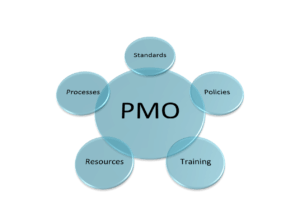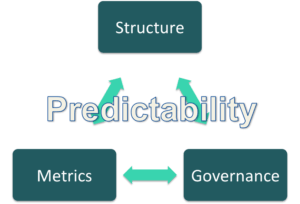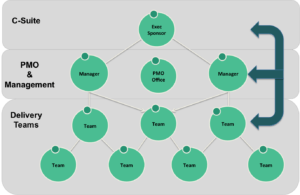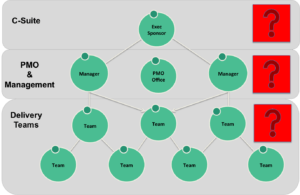Where Does an Agile Transformation Start? Everywhere.
Okay, so your enterprise wants to start an agile transformation. Good for you! We’ll assume you know why you are doing it, what the values are and that it’s not an overnight process.
That still leaves a question of where in the organization do you start? Do you start with a small scale team level approach? Do you get executive sponsorship for a top down push? Do you work through the PMO? And what about middle management?
The answer is, yes.
Let’s look at the various entrance vectors for an agile transformation, and why they can fail.
From the Team Up

When I first gained a formal understanding of agile (like many I’d been doing it for years without realizing it), my basic Shu understanding of agile was very team and individual focused. I think my background in customer service made this a very natural place to go to. As a natural extension of this I believed that “agile must grow from the teams”. If you believe you are agile, you will be.
It was at this time I first came up with my “Better people lead to better teams, better teams to better projects, better projects to better products, better products leads to better companies and better companies will make a better world.” philosophy.
Unfortunately, this is not unlike the kid with a blanket tied around his neck that jumps off his parent’s roof, in the belief he can fly. Belief will only carry you so far in the face of the law of gravity. A team level agile transformation can only go so far in the enterprise before it runs into the impediments of large organizations.
From the Top Down
 At the other end of the spectrum you have agilists that firmly believe an agile transformation must come from the executive level. Without their support, you can never conquer the agile anti-bodies and organizational impediments. The most common problem with this method, is a failure to commit. The executive says “we’re going agile” and may even hire some consultants to come in and help.
At the other end of the spectrum you have agilists that firmly believe an agile transformation must come from the executive level. Without their support, you can never conquer the agile anti-bodies and organizational impediments. The most common problem with this method, is a failure to commit. The executive says “we’re going agile” and may even hire some consultants to come in and help.
Only like the product manager who doesn’t get the shift to being a product owner, the executive does not take part in the transformation. Mandates and visions from the C-Suite rarely succeed unless the executives are willing to invest their time directly into the effort. Even if they do, they can run into strong resistance from the middle without constant support from the top.
Meet in the Middle
 For a time I believed that this was the secret to success. Find a team that wanted to do an agile pilot and get the executive to support this from the top down. This too is fraught with risk. I learned this was not unlike burning the candle at both ends. Pretty soon the middle is melting. Even if the agile pilot was successful, two things would rise up to crush it. The first being most agile pilots are small scale, high performing projects that won’t scale across the organizational impediments. The other problem was that the managers in the middle had a tendency to become detractors out of sheer fear of how this would change their role.
For a time I believed that this was the secret to success. Find a team that wanted to do an agile pilot and get the executive to support this from the top down. This too is fraught with risk. I learned this was not unlike burning the candle at both ends. Pretty soon the middle is melting. Even if the agile pilot was successful, two things would rise up to crush it. The first being most agile pilots are small scale, high performing projects that won’t scale across the organizational impediments. The other problem was that the managers in the middle had a tendency to become detractors out of sheer fear of how this would change their role.
Which led me to to the realization that without middle management bought in and supporting, you could not be successful. This launched me on a quest to help educate managers on what it meant to be a manager in an agile organization. While teaching managers to move from managing tasks, to enabling their teams was certainly valuable, it was not the magic entry point to start a transformation. It did build on my “better people” belief in that I was helping managers to support their directs better, even if they were not doing agile development. That didn’t help me with finding the vector to start an agile transformation.
The PMO

My focus on better managers, combined with my PMI background, led me to explore driving an agile transformation from the program management office. I really thought I was on to something here. The PMO typically owns process or has a lot of influence on it. And as peers to the middle management can exert some strong influence with them. The problems though came from all directions. Teams have a somewhat understanding wariness for the “process of the month” from project managers. “These non-engineers want to tell us how to write software?” Next, while the PMO might be able to get an executive sponsor, more often than not that sponsorship extends only as far as the kick-off meeting. And while the PMO does own process, because agile calls for a fundamental change in how people managers interact with their directs, those managers are usually highly resistant.
So the bottom, the top and the middle all have their challenges for originating an agile transformation. So what do we do?
A Total Approach
While I was exploring coaching better managers, LeadingAgile ‘s founders, Mike and Dennis began to realize that only a systematic approach would work to successfully transform an enterprise scale organization to agile. By establishing an agile structure, governance and metrics, a company could bring clarity to their requirements, accountability (and ability) to the teams and be able to measurably track progress through working, tested software.
This approach doesn’t focus on just one approach vector. Instead it sets up an agile transformation plan from portfolio, through the program level (product owner teams) to the delivery level. When the agile pilot is done, it’s not a cutting edge XP practice or Lean Startup. Instead the pilot is testing the very first step the rest of the organization will also take. The executive sponsor is directly involved, much like a product owner should be. The managers not only know what is happening, they are directly a part of it and get the support they need to be able to support their teams, not drive them to a death march release. And of course the teams get the hands-on help to make a transition to a Shu level agile framework, the first step in a multi-legged journey of an agile transformation.
 Not unlike Agile itself
Not unlike Agile itself
When we talk about creating a stable agile team, we often use the slice of cake analogy. The Scrum team (to pick an agile framework) should have all the skills needed to release an increment of potentially shippable product. An agile transformation needs to be a slice of cake through the organization, with everyone an equal player in the transformation.
When we talk about enterprise agile release ceremonies we have release planning, sprint planning and the standup. With an agile transformation, the portfolio is the release planning, the program is the sprint planning and the teams the daily standup.
Conclusion
If you want a successful enterprise-scale agile transformation, you can’t start at the top, the bottom, or the middle. You have to start all along the continuum, at the same time.
And for me, it’s been a realization that my “better people, better teams” philosophy isn’t a “one leads to the next” progression scale. Instead you have to work with the company as a whole, to make all levels better, together. I still believe better companies will save the world and that’s what I’m doing when I help a company do an enterprise-scale agile transformation.

